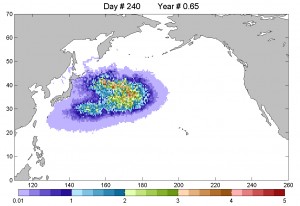University of Hawaii researches are projecting further impacts here on Hawaii Island from the 9.0 earthquake in Japan.
This time, a surge of debris from the destroyed remnants of Japan’s coastal towns are expected to wash ashore in two to five years.
Researchers at the University of Hawaii at Manoa’s International Pacific Research Center have developed a model based on the behavior of drifting buoys deployed over years in the ocean for scientific purposes.
The illustration shows how the debris first spreads out eastward from the Japan Coast.
From the UH press release:
The debris first spreads out eastward from the Japan Coast in the North Pacific Subtropical Gyre. In a year, the Northwestern Hawaiian Islands Marine National Monument will see pieces washing up on its shores; in two years, the remaining Hawaiian islands will see some effects; in three years, the plume will reach the US West Coast, dumping debris on California Beaches and the beaches of British Columbia, Alaska, and Baja California. The debris will then drift into the famous North Pacific Garbage Patch, where it will wander around and break into smaller and smaller pieces. In five years, Hawaii shores can expect to see another barrage of debris that is stronger and longer-lasting than the first one. Much of the debris leaving the North Pacific Garbage Patch ends up on Hawaii’s reefs and beaches in five years, say scientists, Hawaii shores can expect to see another barrage of debris that is stronger and longer-lasting than the first one.
Here on the southern end of the island, the community has been battling a never ending tide of trash, washing ashore on the beaches of Ka’u. The Hawaii Wildlife Fund even held a beach cleanup last week. This new model is not good news for efforts to restore beaches like Kamilo, which has already been dubbed the world’s dirtiest beach for the tons of trash that wash ashore.


by Big Island Video News5:53 pm
on at
STORY SUMMARY
Voice of Stephanie Salazar University of Hawaii researches are projecting further impacts here on Hawaii Island from the 9.0 earthquake in Japan. This time, a surge of debris from the destroyed remnants of Japan’s coastal towns are expected to wash ashore in two to five years. Researchers at the University of Hawaii at Manoa’s International Pacific […]